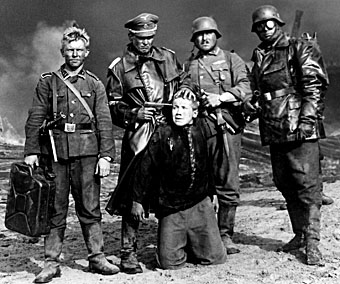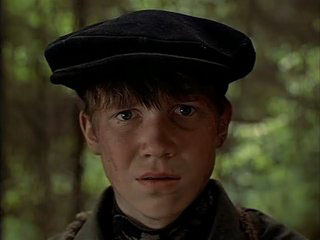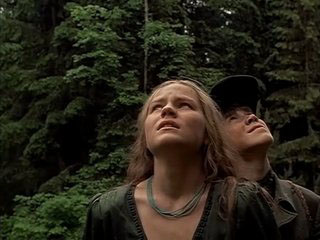
7 ¶ And when he had opened the fourth seal, I heard the voice of the fourth beast say, Come and see.
8 And I looked, and behold a pale horse: and his name that sat on him was Death, and Hell followed with him. And power was given unto them over the fourth part of the earth, to kill with sword, and with hunger, and with death, and with the beasts of the earth.
Revelations 6
There are horror films, there are films about the horror of war, and then there is Elem Klimov’s Come and See (Idi i Smotri). Klimov made the film in 1985 from a screenplay by Ales Adamovich based on that writer’s experiences as a young Russian partisan fighting the Nazis during the Second World War. This biographical quality may be what gives the film its incredible immediacy and authority (Klimov also suffered as a child during the war) even though its power is obviously a product of Klimov’s skills as a director.
I first saw Come and See in a late night television screening at a time when Channel 4 was still showing foreign language films with any regularity. I hadn’t heard of it before, so had no idea what to expect; given the structure of the film this may well be the ideal way to approach it. By the end I was in something like a state of shock, wondering what I’d just been watching. Klimov’s story begins deceptively, and I’ll admit I wasn’t paying much attention for the first half hour. Teenaged Florya digs a rifle out of the sand of an old battlefield so he can join Belarusian partisans in the forest as they prepare to meet invading German forces. His mother is certain she won’t see her son again (a prophetic conviction, although not for the reason she thinks) but he’s obviously full of a naive enthusiasm and won’t be stopped. The scenes in the partisan camp manage to be broadly comedic for the most part (again, deceptively so), the humour only ceasing when Florya is told to stay behind because another man needs his new boots. The next few scenes concern Florya and Glasha, a young girl in love with the partisan leader Kosach, the pair being left alone in the camp. A scene with trees in the pouring rain is especially striking for the way it seems to reference similar moments of lyricism in Andrei Tarkovsky‘s Ivan’s Childhood (1962), another film about the destruction of innocence by the devastation of war.

Klimov has much in common with Tarkovsky in Come and See, especially the way he achieves the same blend of grimy realism and hallucinatory dissonance that Tarkovsky created for Stalker (1979). The woods grow dark, a plane that Florya sees throughout the film drifts silently overhead, parachutes descend—then the trees are ripped apart by massive explosions and the journey into nightmare begins. The explosions leave Florya temporarily deafened and the soundtrack is filled by a piercing electronic whine; this is the origin of the same effect that Steven Spielberg used in Saving Private Ryan. (Roman Polanski has a similar moment in The Pianist when a tank shell strikes a building.) Much was made of the horror and confusion of Spielberg’s battle scenes when that film was released but with little acknowledgement of Klimov’s precedence.
Klimov avoids the usual Hollywood approach of showing events from multiple points of view; there are only one or two shots in the entire film when something is shown occurring while Florya is out of the scene. This has the effect of making his experience our experience, and the narrative is all the more devastating because of it; significantly, Spielberg used the same approach in War of the Worlds. The arrival of the Nazis is typical, they are barely seen at all, and remain out of sight for three quarters of the film, an implicit menace whose presence is felt only in the gunfire that frequently erupts from nowhere, and in the destruction and death they leave behind. The omnipresence of fear and terror begins to affect Florya’s mind as the film unfolds and catastrophe piles up around him. Electronic drones and rumbles are soon an almost permanent feature on the soundtrack and Florya’s face begins to age into a brutalised mask.

The climax comes in an extended sequence depicting the arrival of the Nazis at a small village which they proceed to completely destroy almost as an act of entertainment. Florya escapes but not before being photographed with a gun against his head among a group of soldiers; he was photographed earlier when with the partisans, posing like heroes of the revolution. Adamovich’s script has a number of moments like this, giving the story a subtle but discernible structure that prevents it being a mere catalogue of atrocities. In the final scenes Florya meets a new addition to the partisan army, another teenager dressed the way he was at the beginning of the film; a cycle of terrible inevitability is ready to repeat itself without any of the convenient “closure” so beloved of the Los Angeles school of filmmaking. The destruction of the village and the massacre of its inhabitants leaves the viewer drained and devastated; at the very end we’re told that 628 such villages were destroyed in Belarusia, along with all their people.
Come and See was Klimov’s last film. Like Tarkovsky (who had to leave the USSR to keep working) and Sergei Parajanov, Klimov spent more time battling the Soviet film authorities than making feature films, and eventually he ran out of patience. He died in 2003 and despite influencing expensive Hollywood productions his work still seems criminally underrated outside Russia. The same is true of his wife, Larisa Shepitko, also a director, who made her own film about Belarusia in the Second World War, The Ascent, in 1976. Come and See is difficult but essential viewing. It’s a shame that the American DVD from Kino Video is another of their disgraceful transfers but there’s now a proper Region 2 release available from Nouveaux Pictures. Anyone interested in cinema needs to see this film.

Haven’t seen this film but your description of it reminds me of the 1952 French films in English entitled Forbidden Games although the children in that were much younger.
http://www.imdb.com/title/tt0043686/
Also lyrics to the Waterboys Song Red Army Blues
When I left my home and my family
My mother said to me
Son, it?s not how many germans you kill that counts
It?s how many people you set free
So I packed my bags
Brushed my cap
Walked out into the world
Seventeen years old
Never kissed a girl
‘Forbidden Games’ is a great film but ‘Come and See’ is so far removed from that era of filmmaking it’s unfair to compare them; rather like comparing ‘Apocalypse Now’ to a more conventional (if good for the time) war movie like Robert Aldrich’s ‘Attack’.
3 of the 4 films mentioned make it into 1001 Movies You Must See Before You Die. Only Attack is missing
http://www.listology.com/content_show.cfm/content_id.20774/Movies
Most war movies claim to be antiwar, but have their cake and eat it too by reveling in the gung-ho heroism of competent, can-do heroes. Come and See offers no such relief or comfort. It show there are only victims in war – pg. 720
I have just seen it (got the dvd on ebay).
I was very impressed, its very authentic especially for the era it was made in.
The production has eye for details.
A devastating film, a must see.